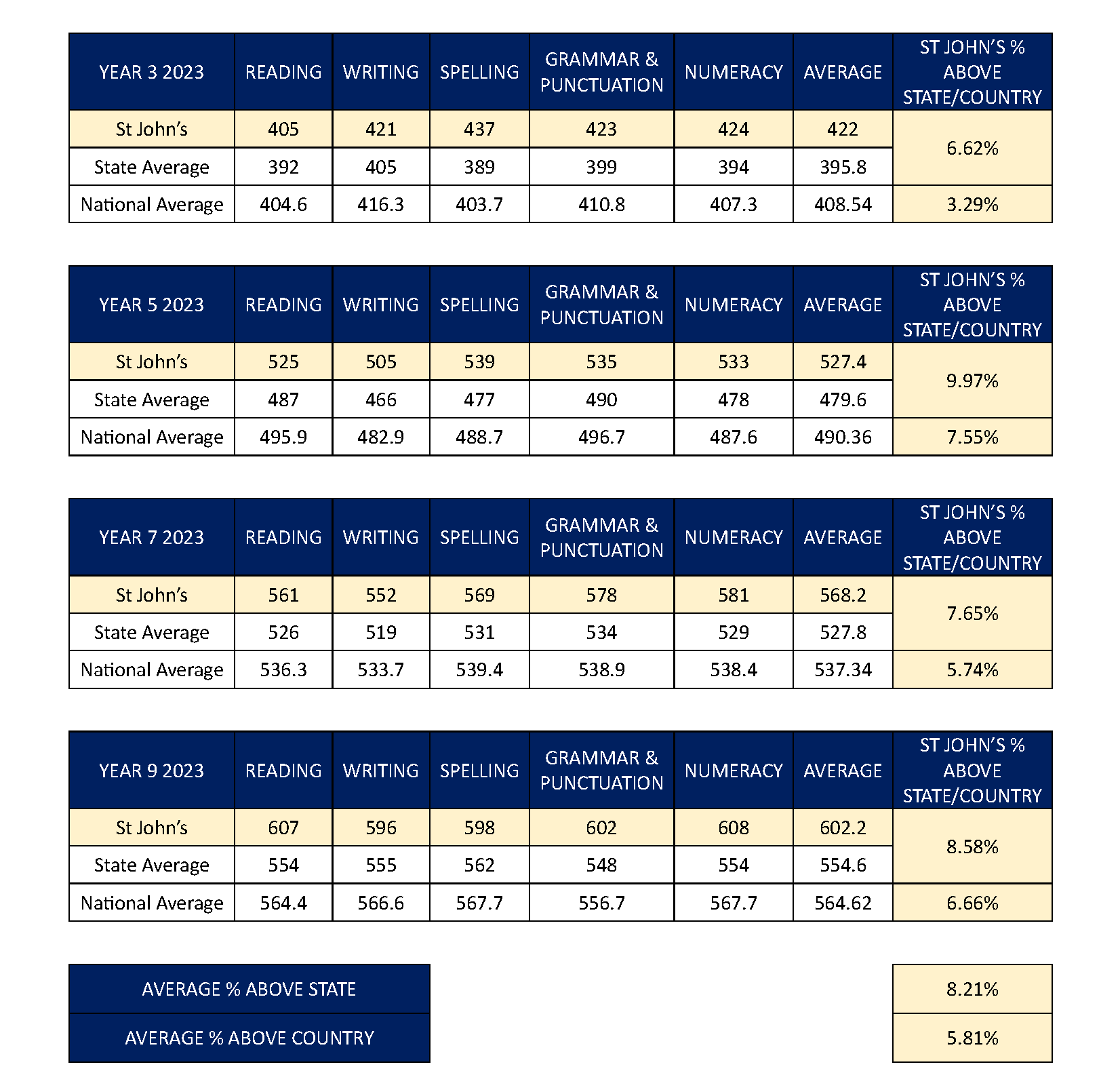After fifteen years of use, the NAPLAN testing program underwent a significant change for the 2023 school year. Earlier changes to an online format were followed by a major change in how student performance on the tests is reported. Prior to 2023, NAPLAN performance was reported using a 10-point band scale; however, this was changed to the four-level proficiency scale for 2023 and beyond. According to ACARA – who administer the NAPLAN test – the changes in reporting have been implemented to give parents and carers earlier, simpler, and clearer information about their child’s NAPLAN achievement based on new, more rigorous national standards.

Table 1: St John’s 2023 NAPLAN Results
Table 1 shows the comparative performance of St John’s students in 2023 against state and national results. It is pleasing to see that St John’s achieved an average of 8.21% above the state, and 5.81% ahead of the national averages. It should also be noted that 97.5% of our students sat the test, which well exceeds the national participation rate of approximately 93%.
In comparison to the state averages, St John’s achieved good results in all levels, with greater numbers of students achieving in the Exceeding and Strong levels, and fewer students in the Developing and Needs additional support levels than the state averages.
Comparison – St John’s to State Average
- Exceeding – 7% higher than the state average.
- Strong – 1% higher than the state average.
- Developing – 9% less than the state average.
- Needs additional support –9% less than the state average.
The NAPLAN testing suite was never designed to compare school against school. Likewise, it was not intended to be used as a league table-style school ranking system. As schools vary enormously in their student make-up, strategic vision, resourcing levels, and teaching focus, whether they are academically selective, or whether they condone absenteeism during NAPLAN testing, school comparison using NAPLAN results is always fundamentally limited in validity.
The fundamental reason for NAPLAN testing is to give a snapshot of how a student is performing in Literacy and Numeracy against state and national benchmarks.
As NAPLAN testing is designed to give one indication of a student’s Literacy and Numeracy at a point in time, deliberate NAPLAN focussed preparation outside of normal teaching and learning practices – i.e., practising for NAPLAN – is inappropriate and risks invalidating the reliability of the testing suite. Both ACARA and the QCAA recommend preparation be confined to students experiencing the style of questions, as well as the test format that students will encounter in the testing suite.
At St John’s, preparation for NAPLAN is embedded in our regular teaching and learning programs, primarily in English and Mathematics lessons; however, elements of Literacy and Numeracy tested via NAPLAN are included in all subject areas. At St John’s, students do not walk into a classroom where the teacher might say “Today we are practising…. for NAPLAN”, but every week from January to November, students do walk into classrooms where content and skills directly related to NAPLAN that are embedded in their normal subject-specific learning experiences.
As a proudly multicultural school, a significant number of our students come from homes where English is not the spoken language. For our students to perform above state and national averages is an outcome to be celebrated, and our students to be congratulated.
St John’s would like to acknowledge and thank our wonderful teaching staff who expertly prepare their students for NAPLAN without them even knowing. They do an outstanding job at decreasing student anxiety and encouraging them to think of NAPLAN as just another test.
Mr Andrew Landroth
Deputy Principal – Curriculum and Innovation





